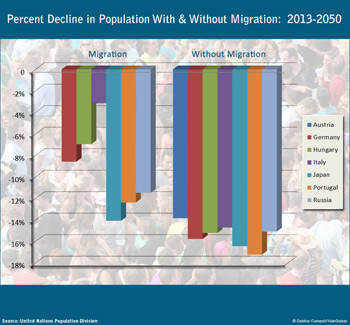The Choice: More Immigrants or Fewer Citizens?
The Choice: More Immigrants or Fewer Citizens?

NEW YORK: An increasing number of countries in the 21st century face a critical choice – more immigrants or fewer citizens. At the forefront of this dilemma for the advanced countries is Japan the population of which will decline by 14 percent in the next four decades. The simple, powerful force behind this predicament is demography. When deaths outnumber births, the unavoidable outcome is population decline – unless immigration makes up for the shortfall.
Today deaths outnumber births in more than a dozen countries including Germany, Hungary, Italy, Japan, Portugal, Russian Federation and Ukraine. Another 24 countries are also expected to see their populations decline by midcentury, even assuming continuing immigration during the coming decades, ranging from a loss of 26 percent for Georgia and Bulgaria to 14 percent for Japan and 5 percent for China.
Furthermore, if immigration were to stop altogether, the population declines for some of those countries, such as Austria, Germany, Italy and the Russian Federation, would be even greater than currently projected (Figure 1). For example, assuming a net number of immigrants of almost 135,000 per year, Italy’s 2050 population is projected to be 3 percent smaller than it is today. Without immigration, Italy’s population would decline by 15 percent by midcentury.
The underlying reason for deaths outnumbering births is not high death rates. It’s simply because birthrates are falling below the replacement level of two births per woman. In the absence of immigration, if a country’s average fertility rate remains below the average of about two births per woman, then its population will eventually and inevitably shrink.
Currently, about 76 countries, including Brazil, Canada, China, Cuba, Iran, Sweden, Thailand and Vietnam, have fertility rates below the replacement level, representing close to half of the world’s population. In addition, one-third of those countries, notably Germany, Italy, Japan, Russia, Singapore, South Korea and Spain, have fertility levels less than 1.5 births per woman. A noteworthy exception is India with a fertility rate at 2.5 births per woman, down from 3.2 births per woman just a decade ago. As a consequence of its comparatively higher birthrate and its enormous size, nearly 1.3 billion, India, which now accounts for 22 percent to of the world’s annual population growth of 78 million, is expected to exceed China’s population in eight years.
If governments in countries with fertility rates persistently below replacement levels wish to stabilize their populations size, then immigration is required to make up for the difference between deaths and births. For example, the net number of immigrants needed to maintain Germany’s current population of almost 82 million throughout the current decade is approximately 200,000 per year, about double the number currently assumed in United Nations population projections. The corresponding annual net numbers of immigrants needed for Japan and Russia to stabilize their populations are even greater, about 230,000 and 350,000, respectively, many times greater than their current immigration levels.
Even for countries that have fertility rates near the two-child replacement level, such as Australia, France, New Zealand, the United Kingdom and the United States, immigration can have an enormous impact on future population growth (Figure 2). In the United Kingdom, for instance, nearly 95 percent of its population growth by midcentury is the result of immigration – both immigrants and their descendants. Also, whereas the midcentury populations of Australia and the United States with migration are projected to increase by 35 percent and 27 percent, respectively, without immigration the projected increases in their populations fall to 10 percent.
In addition to population growth, population aging is another demographic consideration. Many countries, especially those with below-replacement fertility, are facing marked shifts in their age structures, with increased numbers of the aged and declines of those of working age. Italy, for instance, with continuing immigration of nearly 135,0000 per annum is projected by midcentury to see its elderly population increase by 57 percent and its working-age population, ages 20 to 64 years, decline by 22 percent. Without immigration, the decline in Italy’s working-age population is more substantial, doubling to 44 percent.
Even countries with fertility at replacement levels are closely looking at immigration to offset some effects of population aging. For example, with about a million immigrants per year, the United States working-age population, ages 20 to 64, is projected to increase by 17 percent by midcentury. However, if immigration to the United States were halted, its working-age population in 2050 would be about 1 percent smaller than it is today.
Another demographic consideration is the composition of the immigrants. Many of those migrating today are ethnically, religiously and culturally different from the populations of the receiving countries, boosting anxiety about integration and cultural integrity and fears about ethnic conflict. In countries, such as Japan and South Korea, ethnic homogeneity is widely viewed as a positive characteristic. While foreign workers may add to the shrinking Japanese and Korean labor forces to effectively pay for the pensions and healthcare of the elderly, introducing large numbers of immigrants from other cultures is seen as increasing the chances of social unrest and violent clashes as is frequently reported in ethnically diverse nations throughout Africa, Asia, Europe and elsewhere.
While governments, business leaders and various ethnic, social and political organizations may view more immigrants as beneficial – a partial solution to addressing the consequences of declining and aging populations and sometimes even politically and economically advantageous – the general public appears less willing to accept the arrival of large numbers of immigrants. The wide gap between public sentiment and government policy is clearly illustrated by the recent debates, demonstrations and protests in Singapore against government plans to increase immigration to make up for the country’s low birthrate, which at 1.3 births per woman is nearly one child below the replacement level.
The public often perceives immigrants as threatening employment conditions and opportunities, depressing wages, increasing crime, driving up prices, contributing to declines in public education, raising the costs of local services and internal surveillance, and profiteering from social-services entitlements. Public sentiment in many countries is particularly negative towards those unlawfully resident and working in the country. Increased unemployment, poor enforcement of laws and regulations, and a flourishing shadow economy that relies on low-wage illegal workers also contribute to rising anti-immigrant sentiment.
Opinion polls in many countries frequently show that the majority of the public wishes to reduce current immigration levels and prefers that illegal immigrants return to their home countries. In Russia, for example, a recent survey found that two-thirds of the respondents wanted fewer migrants and 73 percent support deporting those in the country illegally.
As is widely recognized, government efforts to raise low fertility rates to replacement levels seem highly unlikely at least for the foreseeable future. Therefore, demography dictates that when deaths outnumber births, population decline is unavoidable unless immigration makes up the shortfall. As the working-age population drops and the numbers elderly rise, immigrants are brought in to sustain the economy, but it can prove destabilizing for the society and politically risky. Although governments may wish it to be different, the laws of demography can neither be repealed nor dismissed. Fewer citizens or more immigrants – this remains a critical choice for an increasing number of countries throughout the 21st century.

